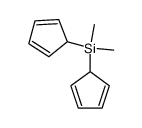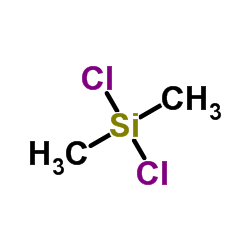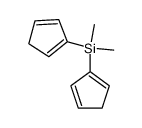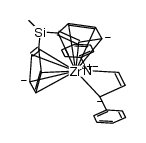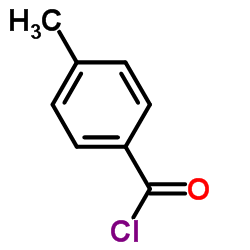86050-32-0
| Name | Dimethylsilylbis(cyclopentadienyl)zirconium dichloride |
|---|
| Molecular Formula | C12H14Cl2SiZr |
|---|---|
| Molecular Weight | 348.45500 |
| Exact Mass | 345.92900 |
| LogP | 4.22980 |
| Appearance | crystal | yellow |
|
Section 1: Product Identification Chemical Name:Dimethylbis(cyclopentadienyl)silyl zirconium dichloride, min. 98% CAS Registry Number:86050-32-0 Formula:[(CH3)2Si(C5H4)2]ZrCl2 EINECS Number:none Chemical Family:metallocene Synonym:Dimethylsilylbis(cyclopentadienyl) zirconium dichloride
Section 2: Composition and Information on Ingredients IngredientCAS NumberPercentACGIH (TWA)OSHA (PEL) Title compound86050-32-0100%5mg/m3 (as Zr)5mg/m3 (as Zr) Section 3: Hazards Identification Emergency Overview:Irritating to skin and eyes. May be irritating to respiratory tract. Primary Routes of Exposure:skin, eyes, ingestion Eye Contact:Causes moderate irritation of the eyes. Skin Contact:Causes moderate irritation of the eyes. Inhalation:May be irritating to the nose, mucous membranes and respiratory tract. Ingestion:No information on the physiological effects of ingestion. Exposure to moisture slowly produces hydrochloric acid. Irritating to skin, eyes. May be irritating to the Acute Health Affects: respiratory tract. Chronic Health Affects:No information available on long-term chronic effects. NTP:No IARC:No OSHA:No SECTION 4: First Aid Measures Immediately flush the eyes with copious amounts of water for at least 10-15 minutes. A victim may need Eye Exposure: assistance in keeping their eye lids open. Get immediate medical attention. Wash the affected area with water. Remove contaminated clothes if necessary. Seek medical assistance if Skin Exposure: irritation persists. Remove the victim to fresh air. Closely monitor the victim for signs of respiratory problems, such as difficulty in Inhalation: breathing, coughing, wheezing or pain. In such cases seek immediate medical assistance. Seek medical attention immediately. Keep the victim calm. Give the victim water (only if conscious). Induce Ingestion: vomiting only if directed by medical personnel. SECTION 5: Fire Fighting Measures Flash Point:none Autoignition Temperature:none Explosion Limits:none Extinguishing Medium:carbon dioxide, foam or dry powder If this product is involved in a fire, firefighters should be equipped with NIOSH approved positive pressure Special Fire Fighting Procedures: self-contained breathing apparatus. Hazardous Combustion andIf involved in a fire this material may emit toxic organic fumes. Decomposion Products: Unusual Fire or Explosion Hazards: No unusual fire or explosion hazards. SECTION 6: Accidental Release Measures Small spills can be mixed with calcium carbonate, sodium bicarbonate or other appropriate acid neutralizing Spill and Leak Procedures: non combustible solid and swept up. SECTION 7: Handling and Storage The material will degrade on prolonged exposure to moisture. Keep bottle tightly sealed and away from heat Handling and Storage: and light. Handle in a dry atmosphere. SECTION 8: Exposure Controls and Personal Protection Eye Protection:Always wear approved safety glasses when handling a chemical substance in the laboratory. Skin Protection:Wear protective clothing and gloves. Ventilation:If possible, handle the material in an efficient fume hood. If ventilation is not available a respirator should be worn. The use of respirators requires a Respiratory Respirator: Protection Program to be in compliance with 29 CFR 1910.134. Ventilation:If possible, handle the material in an efficient fume hood. Additional Protection:No additional protection required. SECTION 9: Physical and Chemical Properties Color and Form:yellow xtl Molecular Weight:348.46 Melting Point:no data Boiling Point:no data Vapor Pressure:no data Specific Gravity:no data Odor:may have an acidic odor Solubility in Water:reacts with water SECTION 10: Stability and Reactivity Stability:moisture-sensitive solid Hazardous Polymerization:No hazardous polymerization. Conditions to Avoid:exposure to moisture Incompatibility:water, strong oxidizing agents Decomposition Products:carbon dioxide, carbon monoxide, hydrogen chloride, organic fumes and zirconium oxide SECTION 11: Toxicological Information RTECS Data:No information available in the RTECS files. Carcinogenic Effects:no data Mutagenic Effects:no data Tetratogenic Effects:no data SECTION 12: Ecological Information Ecological Information:No information available SECTION 13: Disposal Considerations Disposal:Dispose of according to local, state and federal regulations. SECTION 14: Transportation Shipping Name (CFR):Non-hazardous Hazard Class (CFR):NA Additional Hazard Class (CFR):NA Packaging Group (CFR):NA UN ID Number (CFR):NA Shipping Name (IATA):Non-hazardous Hazard Class (IATA):NA Additional Hazard Class (IATA):NA Packaging Group (IATA):NA UN ID Number (IATA):NA SECTION 15: Regulatory Information TSCA:Not listed in the TSCA inventory. SARA (Title 313):Title compound not listed Second Ingredient:none SECTION 16 - ADDITIONAL INFORMATION N/A |
|
~49% 
86050-32-0 |
| Literature: Yasuda, H.; Nagasuna, K.; Akita, M.; Lee, K.; Nakamura, A. Organometallics, 1984 , vol. 3, p. 1470 - 1478 |
|
~45% 
86050-32-0 |
| Literature: Bajgur, Chandrasekhar S.; Tikkanen, Wayne R.; Petersen, Jeffrey L. Inorganic Chemistry, 1985 , vol. 24, p. 2539 - 2546 |
|
~49% 
86050-32-0 |
| Literature: Alt, Helmut G; Ernst, Rainer; Boehmer, Ingrid K Journal of Organometallic Chemistry, 2002 , vol. 658, # 1-2 p. 259 - 265 |
|
~% 
86050-32-0 |
| Literature: Organometallics, , vol. 28, # 10 p. 2938 - 2946 |
|
~% 
86050-32-0 |
| Literature: New Journal of Chemistry, , vol. 14, p. 553 - 558 |
